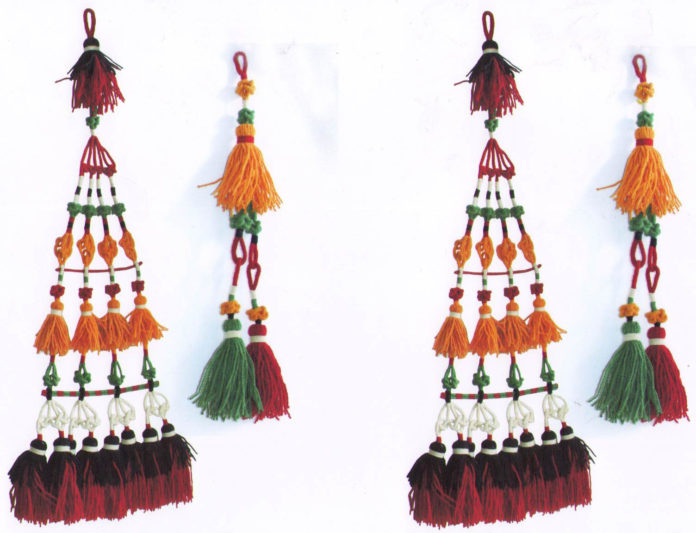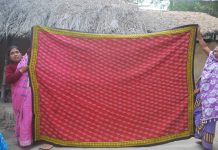Kazakh woven carpets fall into three general categories: pile carpets (tuktyi), flat-woven carpets (takhyr), functional and decorative tent bands for yurts (baskur, bau) made in a combination-technique. Other textiles include hand woven tuskyesteh, wall carpets (tuskiyiz) with heavy hand embroidery, saddle bag (khorzhyn), hand woven tassels (shashakh) for decoration of clothes and the yurt, hand woven men’s outerwear (shekpen), mats made off needlegrass (shiy), and many other ceremonial and textile products.
Kazakhs weave wall and floor carpets. Carpets were not only for decorating purposes, but also protected the yurt from wind, dust, cold/heat and provided noise isolation. To weave a flat-woven carpet (takhyr), a ground loom technique known as teru is used. Takhyr carpets are produced by tightly interweaving the warp and weft strands of the weave to produce a flat surface with no pile. The visible pattern and color are carried by weft strands.
Carpets (tuktyi) made in a pile weave require a lot of time and labor: the coloured weft yarn passes over the two warp yarns, and is pulled through between them and then cut to form the pile. Although trimming of the pile occurs during the weaving, the final clipping is undertaken by an experienced artisan before the carpet is removed from the loom. Each carpet has individual design which is geometrically patterned; the center field consists of two or three large rosettes and is framed by a border. Time taken by a weaver to complete a carpet depends on its size and a complexity of a design. A number of weavers may work together on the same carpet. To weave a 200 cm x 300 cm pile carpet takes 60-90 days and the cooperation of 3-4 weavers. To complete the flat-woven carpet of the same size takes 25-30 days.
Pile (tuktyi) and high pile (khaly) carpets are woven in Shiely and Zhanakhorgan of the Kyzylorda region and in the South Kazakhstan region. Flat-woven carpets (takhyr, alashah) are produced in Aralsk, Kazalynks, Karmakhshy of the Western Kazakhstan and in the Northern Kazakhstan. Traditional and the most popular color used for carpet design is red and its shades. Red symbolizes the celebration of life, prosperity and longevity.
Colorful yurt tent bands (baskur, bau, zhel bau) are made using combination-technique (flat and pile weaving). Yurt bands are an integral part of yurt and easy to produce; they are woven in every region of Kazakhstan. Both the bands and flat-woven carpets are woven on a special narrow loom which is also employed to weave a number of narrow strips that would then be sewn together to create alasha rugs. To achieve the dynamic look of a carpet, alasha were either made from strips of different colors or with designs and pile reliefs. The basic production material is sheep’s wool, goat wool and horse hair, natural cotton and silk fibres. It is also common to add camel or goat wool to warp yarn to add durability.
Modern weavers include G. Kozhamzharova (Katon-Karaghay, the Eastern Kazakhstan), B. Symova, M. Akhmetova, K. Aydarbekova, G. Begaliyeva (Shymkent, the Southern Kazakhstan), and a cooperative in Shuldeh (the Southern Kazakhstan), S. Khozhantayeva, R. Alibatyrova, K. Yikhanova, К. Bedenkulova (Kyzylorda region) and A. Sagynayeva (the Western Kazakhstan).





